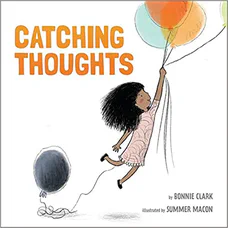Catching Thoughts

Recommended Age Range: Preschool through 2nd grade.
Publisher's Summary:
Have you ever had an unwelcome thought that you just couldn’t lose, no matter how hard you tried to push it away? For every child who has been weighed down by sadness or anxiety, this charming story about a little girl who has a thought she simply cannot lose teaches kids how to acknowledge unwanted thoughts, show them compassion, then actively let them go.

Dr. Annie's Takeaways
Recommended for: This book is the only one that I’ve found that specifically addresses intrusive thoughts, which some children experience as their primary symptom of OCD (as in “Pure O” OCD). Using a visual metaphor of thoughts as different colored balloons, it validates how ineffective it is to try avoid an unwanted thought, and it encourages children to look directly at a thought in order to recognize that perhaps it’s not as big as a child feared. It veers from there to encouraging a child to “catch” other types of thoughts instead (lovely thoughts, calm thoughts, true thoughts). I have a few reservations about the way that the book talks about these thoughts (they’re labeled “good thoughts”), but with a thoughtful discussion, this book presents a helpful exercise to take the fear out of intrusive thoughts and to help a child to practice a mindfulness exercise of choosing which thoughts to catch and which to let go.
Would a child like it? There’s not much plot, but the visual metaphor is sweet and effective, and for a child being weighed down by an unwanted or intrusive thought, this book could provide some relief.
Evidence-Based Practices:
Mindfulness
Tone: Peaceful, hopeful
Story Quality: This story uses different colored balloons as a visual metaphor for thoughts. It’s an effective introduction to the mindfulness strategy of noting thoughts (i.e., acknowledging one’s thoughts, even the uncomfortable ones, and choosing which ones to gently let go). The story is simple and not necessarily super interesting on its own, but it effectively teaches a skill in a clear and relatively engaging manner.
Illustrations: Beautiful, expressive illustrations with an effective use of color to indicate the little girl’s feelings. Her unwanted thought is gray, while other thoughts are more colorful.
Representation: The narrator is a little girl with light brown skin and black hair that has a lot of body and texture. The setting is fairly abstract, but she appears to live in a rural area with green hills and houses far apart from each other.
Psychological Practices: The most effective part of this book is the first half when the narrator is sharing how her efforts to push away and avoid her unwanted thought just made it bigger and more present, until she “took a deep breath and looked at it. Maybe it wasn’t so big.” This part of the book is likely to be validating to a child who has been trying not to think about something and finding that it isn’t working at all. It also sets up an introduction to Exposure and Response Prevention (ERP)
for intrusive thoughts (i.e., looking straight at a feared thought until it loses its power). The book then shows the little girl realizing that there are many other types of thoughts around her, represented by different colored balloons: lovely thoughts, true thoughts, hopeful thoughts, etc. She “catches” these thoughts and as she does so, the unwanted thought gets smaller and smaller. It ends with the line, “And whenever the old thought tries to come back into view…I can just say, “Hello” and politely ask it to leave…and fill my world with all the good thoughts that I choose to put in my mind instead.” This section can be used to talk about how it’s easier to shift our attention to something than away from something (which is often nearly impossible), and the whole book sets up a mindfulness exercise of drawing and/or visualizing thoughts in balloons and deciding which ones to hold onto and which to let go of and picture floating gently away (the thought getting smaller and smaller until poof it disappears). However, I also have some concerns, shared below.
Concerns: I was a bit on the fence about including this book and ultimately decided to do so because there just aren’t a lot of options to help children with intrusive thoughts. The first half of the book is really excellent, and the mindfulness exercise that the book inspires is also useful, so I’ve included the book on the Bookshelf. That said, labeling thoughts as “good thoughts” implies that there are bad thoughts, and this can actually make a child’s intrusive thoughts scarier and stickier. I much prefer using language like “OCD Thoughts” vs. “[child’s name] Thoughts” or “Unhelpful Thoughts” vs. “Helpful Thoughts.” I also wish the book had lingered a little longer on the importance of not avoiding the unwanted thought. It transitioned a little too quickly to the idea of catching “good thoughts” which could be misconstrued as a strategy of just “thinking positively,” another message that can be harmful to a child with intrusive thoughts (and can actually become a type of compulsion–replacing “bad thoughts” with “good thoughts”).
